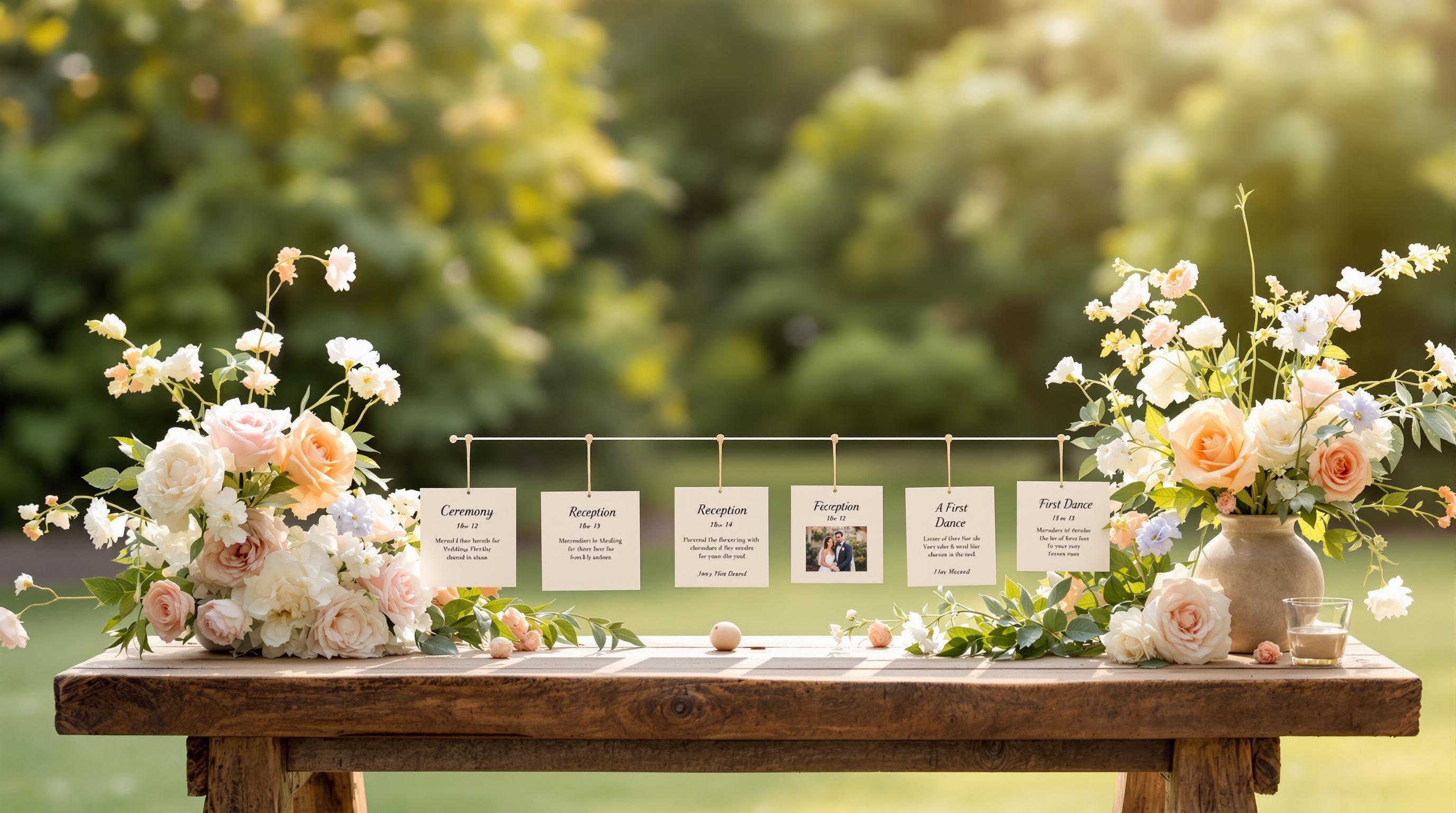
How to Create a Group Photo Timeline for Weddings
Planning group photos for a wedding can feel overwhelming, but a clear timeline ensures everything runs smoothly. Here's a quick guide to get you started:
- Allocate Time: Plan 20–30 minutes for family photos and 15–30 minutes for wedding party shots. Add buffer time for unexpected delays.
- Key Events: Anchor your timeline around the ceremony, reception, and sunset for outdoor photos.
- Photo Checklist: List group combinations (e.g., couple with parents, full wedding party) and share with your photographer.
- Order of Photos: Start with family photos, then wedding party shots, and include a "first look" session if desired.
- Use Tools: Apps like Hitched help coordinate schedules and share photos in real time.
- Assign a Coordinator: Have someone manage the schedule and gather people for group shots.
Pro Tip: Review your timeline with your photographer 48 hours before the wedding to confirm details like lighting and locations. A well-prepared plan ensures stress-free, memorable photos.
Step 1: Build Your Basic Timeline
Start by identifying key fixed points in your schedule and work backward from there. Clear communication with your photographer and everyone involved is crucial at this stage.
Pinpoint Key Event Times
Focus on these important moments:
- Ceremony start – the main anchor for your timeline
- Reception entrance – usually follows the ceremony
- Sunset – essential for outdoor photos
- Special moments – like speeches or first dances
Create Your Photo Checklist
Prepare a detailed list of group photos you want. Immediate family pictures usually take about 2–3 minutes per grouping. Here's an example:
| Group Combination | Estimated Time |
|---|---|
| Couple with both sets of parents | 3 minutes |
| Couple with each set of parents | 4–6 minutes |
| Individual family units | 2–3 minutes each |
| Extended family groupings | 3–4 minutes each |
| Full wedding party | 5–7 minutes |
Share this list with your photographer to ensure nothing is missed.
Coordinate With Your Photographer
Schedule a meeting with your photographer well ahead of the wedding. Review your checklist and discuss key details, such as:
- Photo locations – pick ideal spots and plan backups for bad weather
- Lighting needs – decide if extra equipment will be required
- Group management – strategize for handling larger groups
- Buffer time – include extra minutes to account for delays
Your photographer's experience with similar events can help fine-tune your timeline and avoid potential hiccups. Tools like Hitched can also help you share schedules and keep everyone updated in real time.
Step 2: Plan Group Photo Order
Once you've outlined your basic timeline, it's time to organize your group photos. A well-thought-out photo order ensures a smooth process, keeps everyone at ease, and captures all the key moments.
Start with Family Photos
Kick off with immediate family photos during the pre-ceremony period. This is when everyone is fresh and readily available. Starting early helps you capture vibrant family portraits without feeling rushed.
Here’s a suggested breakdown for pre-ceremony family photos:
| Time Block | Group Configuration | Duration |
|---|---|---|
| Pre-ceremony | Bride/Groom + Parents | 6–8 minutes |
| Pre-ceremony | Individual Parent Photos | 8–10 minutes |
| Pre-ceremony | Siblings + Partners | 10–12 minutes |
| Pre-ceremony | Grandparents | 5–6 minutes |
Schedule Wedding Party Photos Next
After family photos, transition into wedding party shots to keep the momentum going. Allocate around 20–25 minutes for these. Break it into smaller segments for better flow:
- A full group shot (about 7–8 minutes)
- Smaller groupings, like bridesmaids or groomsmen (5–6 minutes each)
- Quick couple shots (1–2 minutes each)
This sequence ensures you capture all the essential groupings before moving on to the next step.
Plan for First Look Photos
A first look session is a great way to capture intimate portraits and reduce stress later in the day. Schedule this 30–60 minutes before the ceremony. The session typically takes about 30 minutes and includes both the emotional first look and couple portraits.
Here’s an example timeline for a 4:00 PM ceremony:
| Time | Activity |
|---|---|
| 1:45 PM | First Look + Couple Portraits |
| 2:30 PM | Wedding Party Photos |
| 3:00 PM | Immediate Family Photos |
| 3:30 PM | Final Touch-ups |
| 4:00 PM | Ceremony Begins |
sbb-itb-49fad82
Step 3: Use Apps and Tools
Now that your timeline is set and group order is planned, it’s time to use digital tools to keep everything running smoothly.
Set Up a Private Event Feed on Hitched

Hitched can simplify organizing group photos and make real-time sharing easy. Set up your event feed ahead of time so guests can join and start uploading photos into organized albums. Don’t forget to test the upload process before the big day to avoid any surprises.
Share Your Timeline
Make sure your photo timeline reaches everyone by sharing it through multiple channels like email, your wedding website, and app notifications. Clearly outline group assignments, locations, and session times. Adding some buffer time between sessions can help keep things on track if there are any delays.
Plan Day-of Communications
Assign a photo coordinator to keep everything on schedule. They can use Hitched’s notification system to guide guests to the right photo locations and communicate with the photography team. This helps keep the group photo sessions organized without disrupting the celebration.
Step 4: Prepare for Wedding Day
Good planning makes sure every special moment gets documented.
Double-Check Your Timeline
Go over your timeline with your photographer at least 48 hours before the big day. Confirm key details like:
- Lighting at each location
- Travel time between venues
- Timing for getting ready, the first look, and sunset shots
This final review helps avoid surprises and keeps everything on track.
Build in Buffer Time
Add extra time to your schedule for unexpected delays. Here's a quick guide for how much buffer time to include:
| Photo Session Type | Suggested Buffer Time |
|---|---|
| Family Groups | 15-20 minutes |
| Wedding Party | 20-30 minutes |
| Couple Portraits | 15-20 minutes |
| Large Group Photos | 25-30 minutes |
These extra minutes give you breathing room if things run behind. Once your schedule is set, assign someone to oversee it throughout the day.
Assign a Photo Coordinator
A dedicated photo coordinator can help everything run smoothly. Their job includes:
- Keeping track of the photo schedule
- Gathering people for group shots
- Communicating with the photography team
- Adjusting the schedule as needed
- Working with venue staff to ensure access to locations
This person should arrive early and have both printed and digital versions of the timeline. They’ll work closely with your photographers and can use an app for real-time updates to stay organized.
Conclusion: Making Your Photo Timeline Work
Creating a wedding photo timeline takes thoughtful planning, but it ensures every special moment is captured while keeping the day running smoothly.
Start by identifying key events like the ceremony and sunset shots, then work backward to fit in group photos. Family portraits should be scheduled early when everyone is energized and present.
Digital tools can simplify the process. Platforms like Hitched allow you to organize and share photos seamlessly through secure, private event feeds.
Here’s a quick overview of what makes a photo timeline effective:
| Element | Purpose | Benefit |
|---|---|---|
| Buffer Time | Avoids rushing | Lowers stress and ensures better photos |
| Photo Coordinator | Handles logistics | Keeps everyone on track |
| Digital Tools | Simplifies sharing | Helps create a complete collection |
